check engine FORD E SERIES 2000 4.G Owner's Manual
[x] Cancel search | Manufacturer: FORD, Model Year: 2000, Model line: E SERIES, Model: FORD E SERIES 2000 4.GPages: 232, PDF Size: 2.58 MB
Page 168 of 232
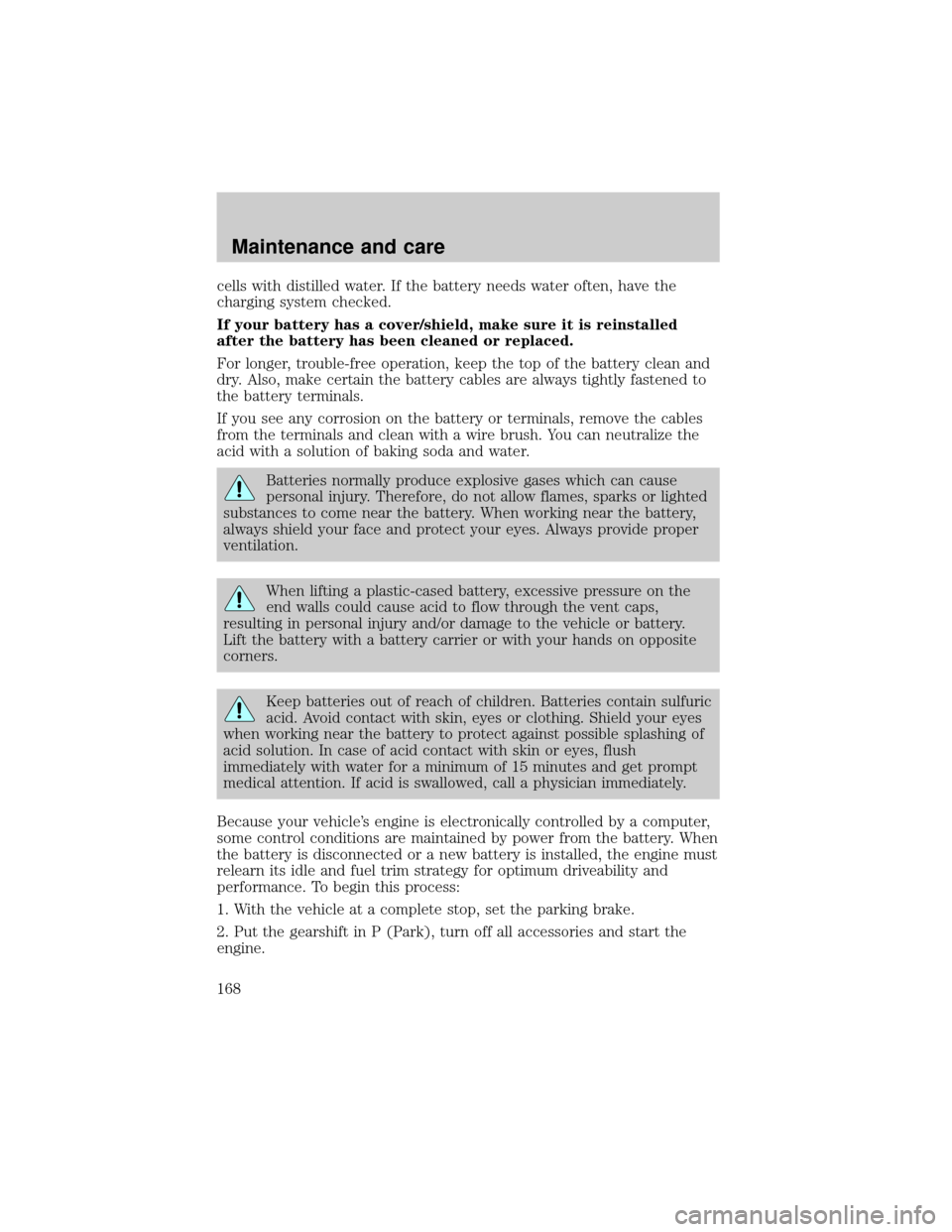
cells with distilled water. If the battery needs water often, have the
charging system checked.
If your battery has a cover/shield, make sure it is reinstalled
after the battery has been cleaned or replaced.
For longer, trouble-free operation, keep the top of the battery clean and
dry. Also, make certain the battery cables are always tightly fastened to
the battery terminals.
If you see any corrosion on the battery or terminals, remove the cables
from the terminals and clean with a wire brush. You can neutralize the
acid with a solution of baking soda and water.
Batteries normally produce explosive gases which can cause
personal injury. Therefore, do not allow flames, sparks or lighted
substances to come near the battery. When working near the battery,
always shield your face and protect your eyes. Always provide proper
ventilation.
When lifting a plastic-cased battery, excessive pressure on the
end walls could cause acid to flow through the vent caps,
resulting in personal injury and/or damage to the vehicle or battery.
Lift the battery with a battery carrier or with your hands on opposite
corners.
Keep batteries out of reach of children. Batteries contain sulfuric
acid. Avoid contact with skin, eyes or clothing. Shield your eyes
when working near the battery to protect against possible splashing of
acid solution. In case of acid contact with skin or eyes, flush
immediately with water for a minimum of 15 minutes and get prompt
medical attention. If acid is swallowed, call a physician immediately.
Because your vehicle's engine is electronically controlled by a computer,
some control conditions are maintained by power from the battery. When
the battery is disconnected or a new battery is installed, the engine must
relearn its idle and fuel trim strategy for optimum driveability and
performance. To begin this process:
1. With the vehicle at a complete stop, set the parking brake.
2. Put the gearshift in P (Park), turn off all accessories and start the
engine.
Maintenance and care
168
Page 182 of 232
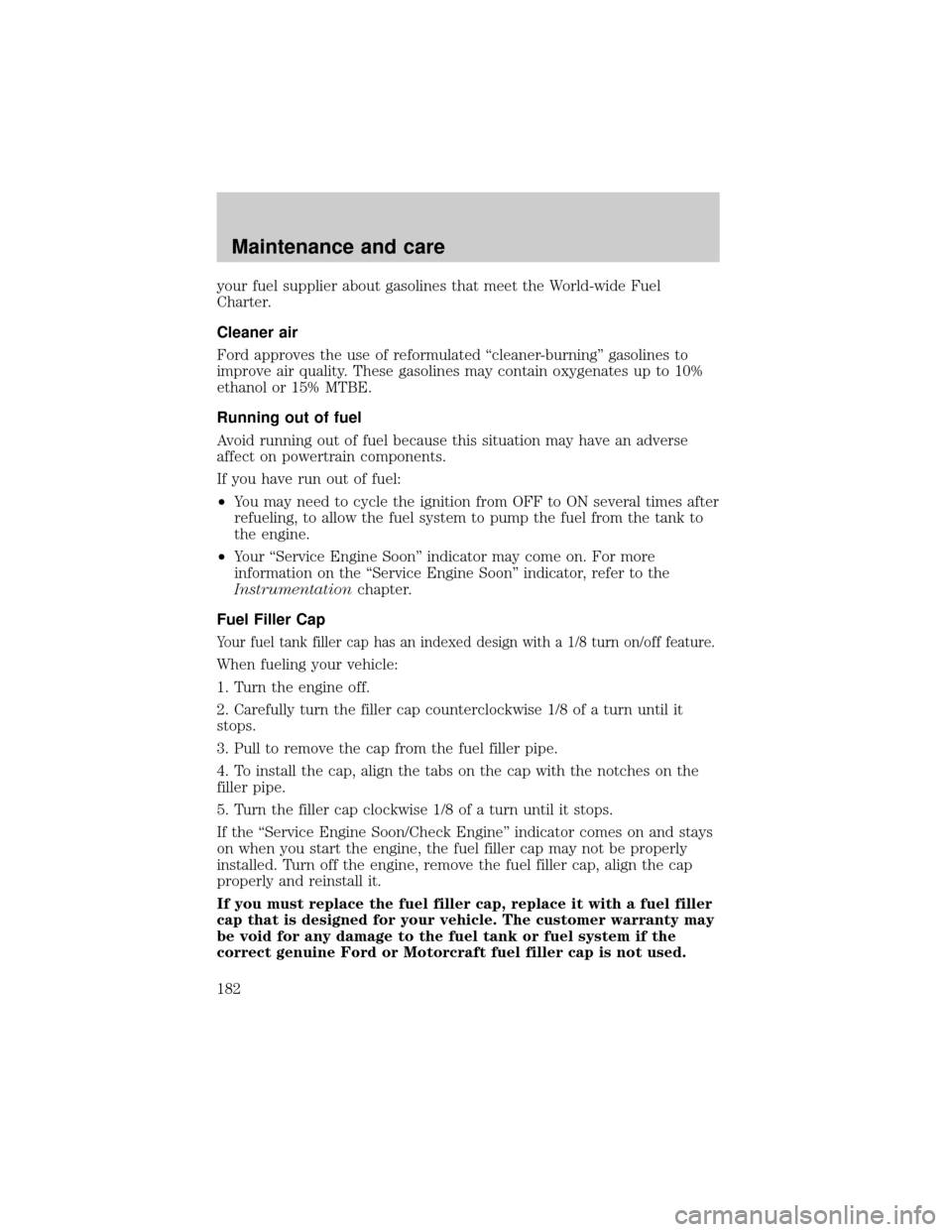
your fuel supplier about gasolines that meet the World-wide Fuel
Charter.
Cleaner air
Ford approves the use of reformulated ªcleaner-burningº gasolines to
improve air quality. These gasolines may contain oxygenates up to 10%
ethanol or 15% MTBE.
Running out of fuel
Avoid running out of fuel because this situation may have an adverse
affect on powertrain components.
If you have run out of fuel:
²You may need to cycle the ignition from OFF to ON several times after
refueling, to allow the fuel system to pump the fuel from the tank to
the engine.
²Your ªService Engine Soonº indicator may come on. For more
information on the ªService Engine Soonº indicator, refer to the
Instrumentationchapter.
Fuel Filler Cap
Your fuel tank filler cap has an indexed design with a 1/8 turn on/off feature.
When fueling your vehicle:
1. Turn the engine off.
2. Carefully turn the filler cap counterclockwise 1/8 of a turn until it
stops.
3. Pull to remove the cap from the fuel filler pipe.
4. To install the cap, align the tabs on the cap with the notches on the
filler pipe.
5. Turn the filler cap clockwise 1/8 of a turn until it stops.
If the ªService Engine Soon/Check Engineº indicator comes on and stays
on when you start the engine, the fuel filler cap may not be properly
installed. Turn off the engine, remove the fuel filler cap, align the cap
properly and reinstall it.
If you must replace the fuel filler cap, replace it with a fuel filler
cap that is designed for your vehicle. The customer warranty may
be void for any damage to the fuel tank or fuel system if the
correct genuine Ford or Motorcraft fuel filler cap is not used.
Maintenance and care
182
Page 185 of 232
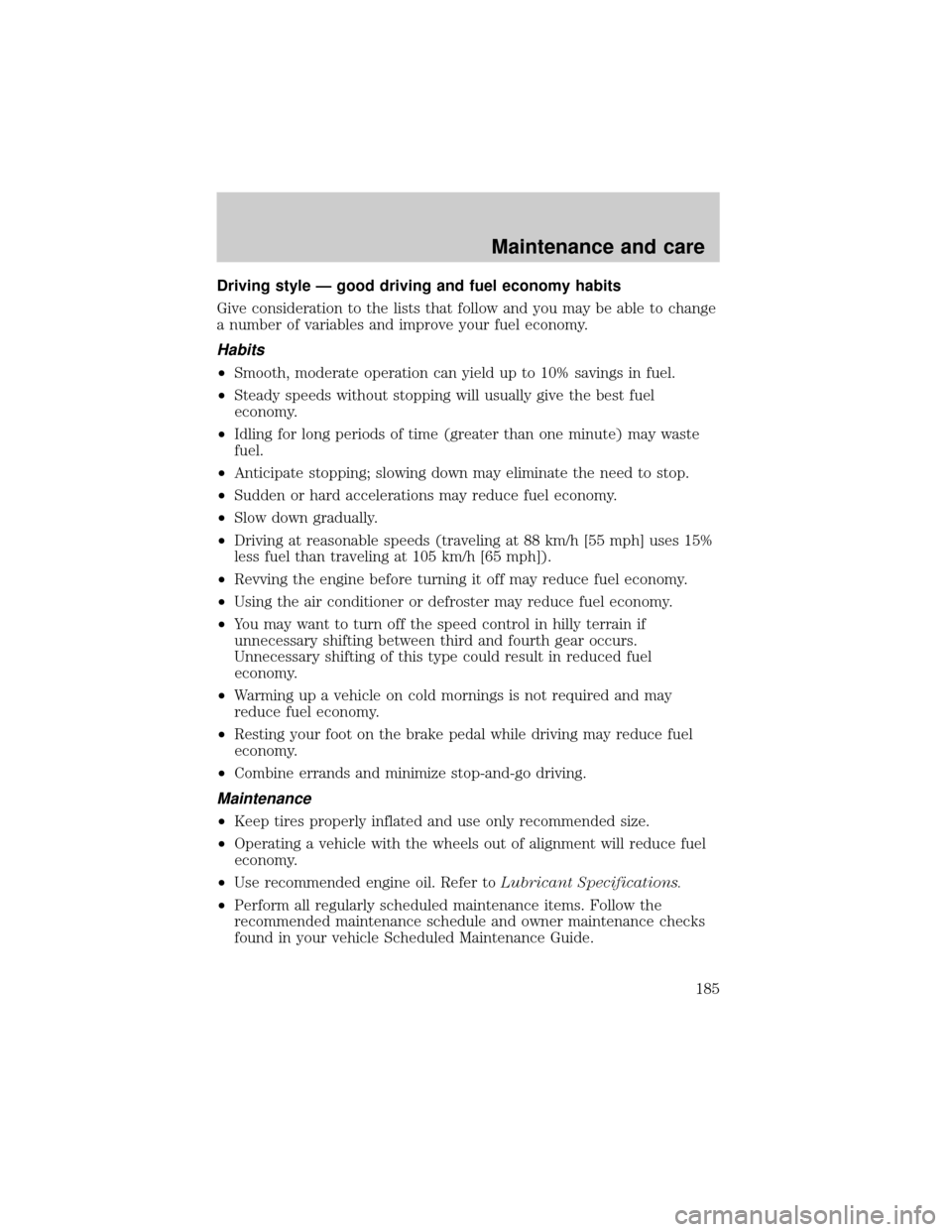
Driving style Ð good driving and fuel economy habits
Give consideration to the lists that follow and you may be able to change
a number of variables and improve your fuel economy.
Habits
²Smooth, moderate operation can yield up to 10% savings in fuel.
²Steady speeds without stopping will usually give the best fuel
economy.
²Idling for long periods of time (greater than one minute) may waste
fuel.
²Anticipate stopping; slowing down may eliminate the need to stop.
²Sudden or hard accelerations may reduce fuel economy.
²Slow down gradually.
²Driving at reasonable speeds (traveling at 88 km/h [55 mph] uses 15%
less fuel than traveling at 105 km/h [65 mph]).
²Revving the engine before turning it off may reduce fuel economy.
²Using the air conditioner or defroster may reduce fuel economy.
²You may want to turn off the speed control in hilly terrain if
unnecessary shifting between third and fourth gear occurs.
Unnecessary shifting of this type could result in reduced fuel
economy.
²Warming up a vehicle on cold mornings is not required and may
reduce fuel economy.
²Resting your foot on the brake pedal while driving may reduce fuel
economy.
²Combine errands and minimize stop-and-go driving.
Maintenance
²Keep tires properly inflated and use only recommended size.
²Operating a vehicle with the wheels out of alignment will reduce fuel
economy.
²Use recommended engine oil. Refer toLubricant Specifications.
²Perform all regularly scheduled maintenance items. Follow the
recommended maintenance schedule and owner maintenance checks
found in your vehicle Scheduled Maintenance Guide.
Maintenance and care
185
Page 187 of 232
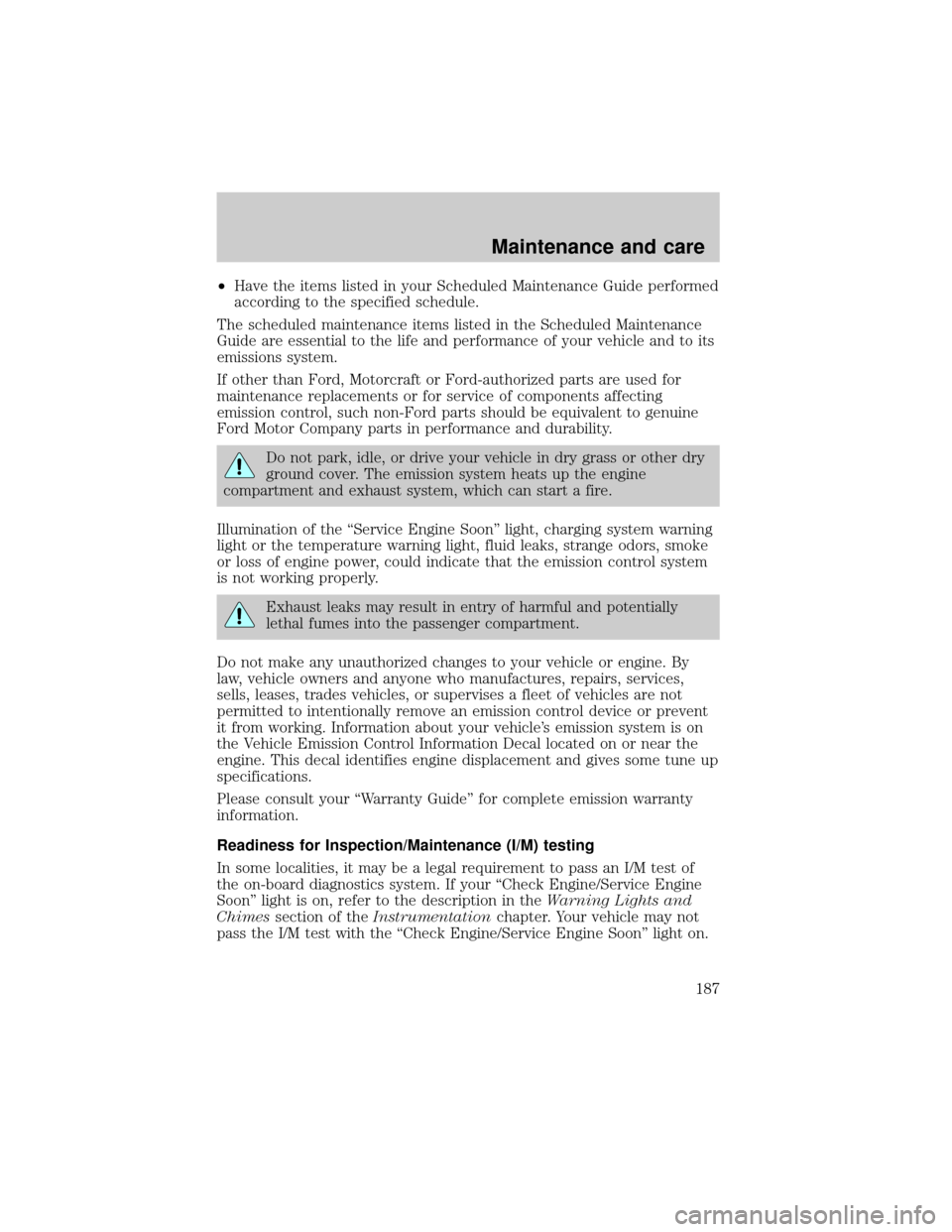
²Have the items listed in your Scheduled Maintenance Guide performed
according to the specified schedule.
The scheduled maintenance items listed in the Scheduled Maintenance
Guide are essential to the life and performance of your vehicle and to its
emissions system.
If other than Ford, Motorcraft or Ford-authorized parts are used for
maintenance replacements or for service of components affecting
emission control, such non-Ford parts should be equivalent to genuine
Ford Motor Company parts in performance and durability.
Do not park, idle, or drive your vehicle in dry grass or other dry
ground cover. The emission system heats up the engine
compartment and exhaust system, which can start a fire.
Illumination of the ªService Engine Soonº light, charging system warning
light or the temperature warning light, fluid leaks, strange odors, smoke
or loss of engine power, could indicate that the emission control system
is not working properly.
Exhaust leaks may result in entry of harmful and potentially
lethal fumes into the passenger compartment.
Do not make any unauthorized changes to your vehicle or engine. By
law, vehicle owners and anyone who manufactures, repairs, services,
sells, leases, trades vehicles, or supervises a fleet of vehicles are not
permitted to intentionally remove an emission control device or prevent
it from working. Information about your vehicle's emission system is on
the Vehicle Emission Control Information Decal located on or near the
engine. This decal identifies engine displacement and gives some tune up
specifications.
Please consult your ªWarranty Guideº for complete emission warranty
information.
Readiness for Inspection/Maintenance (I/M) testing
In some localities, it may be a legal requirement to pass an I/M test of
the on-board diagnostics system. If your ªCheck Engine/Service Engine
Soonº light is on, refer to the description in theWarning Lights and
Chimessection of theInstrumentationchapter. Your vehicle may not
pass the I/M test with the ªCheck Engine/Service Engine Soonº light on.
Maintenance and care
187
Page 188 of 232

If the vehicle's powertrain system or its battery has just been serviced,
the on-board diagnostics system is reset to a ªnot ready for I/M testº
condition. To ready the on-board diagnostics system for I/M testing, a
minimum of 30 minutes of city and highway driving is necessary as
described below:
²First, at least 10 minutes of driving on an expressway or highway.
²Next, at least 20 minutes driving in stop-and-go, city-type traffic with
at least four idle periods.
Allow the vehicle to sit for at least eight hours without starting the
engine. Then, start the engine and complete the above driving cycle. The
engine must warm up to its normal operating temperature. Once started,
do not turn off the engine until the above driving cycle is complete.
BULBS
Replacing exterior bulbs
Check the operation of the following lamps frequently:
²Headlamps
²Tail lamps
²Brakelamps
²High-mount brakelamp
²Turn signals
²Backup lamps
²License plate lamp
Do not remove lamp bulbs unless they will be replaced immediately. If a
bulb is removed for an extended period of time, contaminants may enter
the lamp housings and affect performance.
Replacing headlamp bulbs (aerodynamic)
To remove the headlamp bulb:
1. Make sure headlamp switch is in OFF position.
2. Open the hood.
Maintenance and care
188
Page 202 of 232
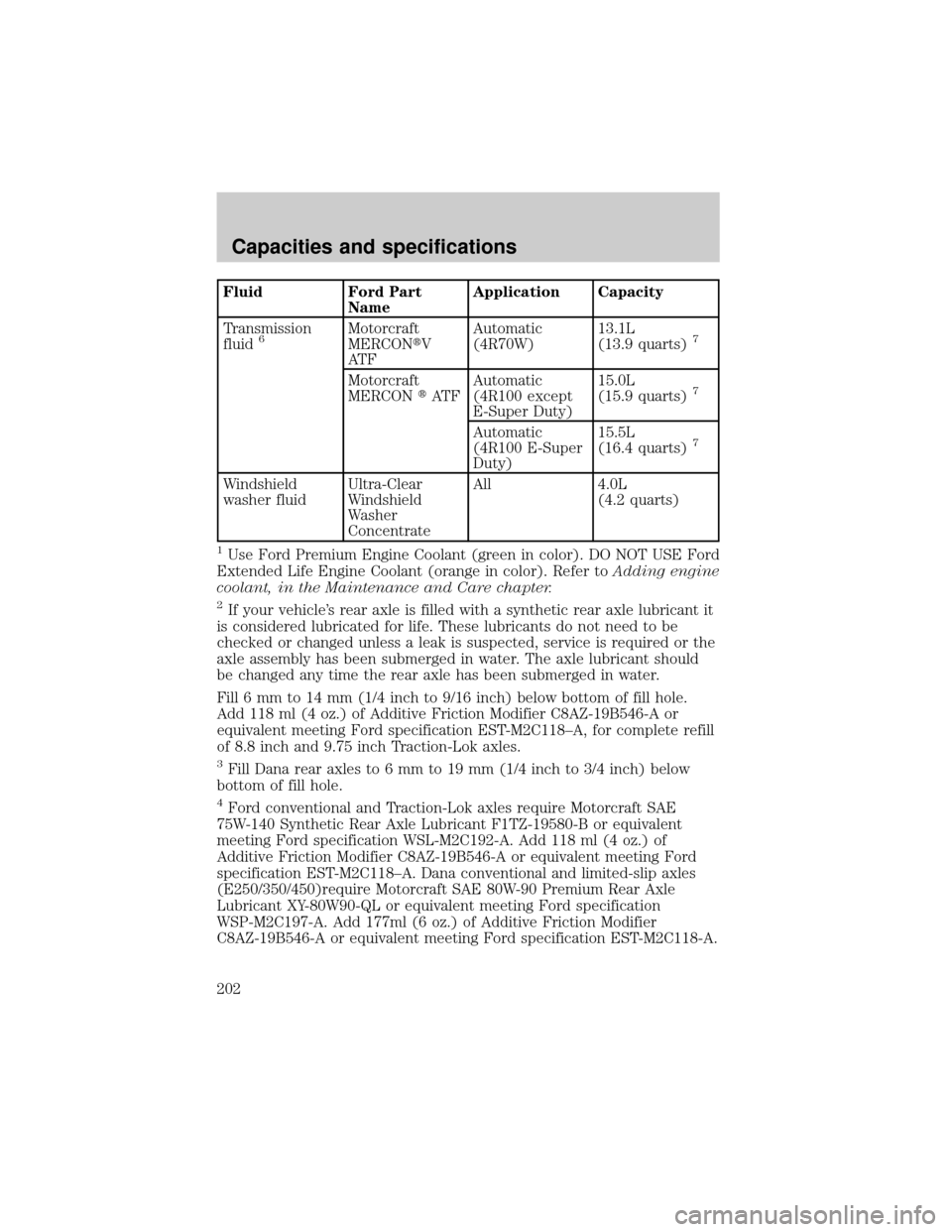
Fluid Ford Part
NameApplication Capacity
Transmission
fluid
6Motorcraft
MERCONtV
AT FAutomatic
(4R70W)13.1L
(13.9 quarts)7
Motorcraft
MERCONtAT FAutomatic
(4R100 except
E-Super Duty)15.0L
(15.9 quarts)7
Automatic
(4R100 E-Super
Duty)15.5L
(16.4 quarts)7
Windshield
washer fluidUltra-Clear
Windshield
Washer
ConcentrateAll 4.0L
(4.2 quarts)
1Use Ford Premium Engine Coolant (green in color). DO NOT USE Ford
Extended Life Engine Coolant (orange in color). Refer toAdding engine
coolant, in the Maintenance and Care chapter.
2If your vehicle's rear axle is filled with a synthetic rear axle lubricant it
is considered lubricated for life. These lubricants do not need to be
checked or changed unless a leak is suspected, service is required or the
axle assembly has been submerged in water. The axle lubricant should
be changed any time the rear axle has been submerged in water.
Fill 6 mm to 14 mm (1/4 inch to 9/16 inch) below bottom of fill hole.
Add 118 ml (4 oz.) of Additive Friction Modifier C8AZ-19B546-A or
equivalent meeting Ford specification EST-M2C118±A, for complete refill
of 8.8 inch and 9.75 inch Traction-Lok axles.
3Fill Dana rear axles to 6 mm to 19 mm (1/4 inch to 3/4 inch) below
bottom of fill hole.
4Ford conventional and Traction-Lok axles require Motorcraft SAE
75W-140 Synthetic Rear Axle Lubricant F1TZ-19580-B or equivalent
meeting Ford specification WSL-M2C192-A. Add 118 ml (4 oz.) of
Additive Friction Modifier C8AZ-19B546-A or equivalent meeting Ford
specification EST-M2C118±A. Dana conventional and limited-slip axles
(E250/350/450)require Motorcraft SAE 80W-90 Premium Rear Axle
Lubricant XY-80W90-QL or equivalent meeting Ford specification
WSP-M2C197-A. Add 177ml (6 oz.) of Additive Friction Modifier
C8AZ-19B546-A or equivalent meeting Ford specification EST-M2C118-A.
Capacities and specifications
202
Page 203 of 232
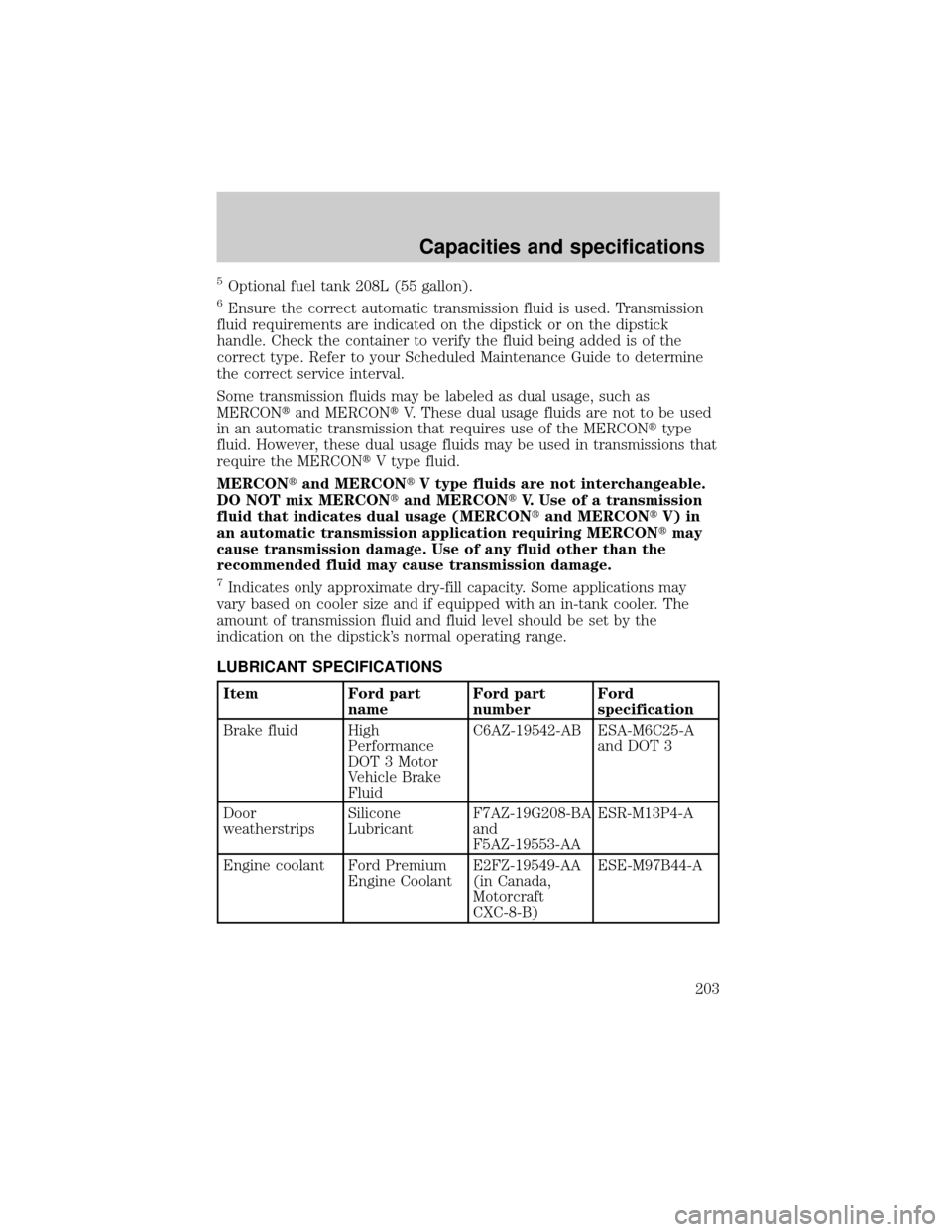
5Optional fuel tank 208L (55 gallon).
6Ensure the correct automatic transmission fluid is used. Transmission
fluid requirements are indicated on the dipstick or on the dipstick
handle. Check the container to verify the fluid being added is of the
correct type. Refer to your Scheduled Maintenance Guide to determine
the correct service interval.
Some transmission fluids may be labeled as dual usage, such as
MERCONtand MERCONtV. These dual usage fluids are not to be used
in an automatic transmission that requires use of the MERCONttype
fluid. However, these dual usage fluids may be used in transmissions that
require the MERCONtV type fluid.
MERCONtand MERCONtV type fluids are not interchangeable.
DO NOT mix MERCONtand MERCONtV. Use of a transmission
fluid that indicates dual usage (MERCONtand MERCONtV) in
an automatic transmission application requiring MERCONtmay
cause transmission damage. Use of any fluid other than the
recommended fluid may cause transmission damage.
7Indicates only approximate dry-fill capacity. Some applications may
vary based on cooler size and if equipped with an in-tank cooler. The
amount of transmission fluid and fluid level should be set by the
indication on the dipstick's normal operating range.
LUBRICANT SPECIFICATIONS
Item Ford part
nameFord part
numberFord
specification
Brake fluid High
Performance
DOT 3 Motor
Vehicle Brake
FluidC6AZ-19542-AB ESA-M6C25-A
and DOT 3
Door
weatherstripsSilicone
LubricantF7AZ-19G208-BA
and
F5AZ-19553-AAESR-M13P4-A
Engine coolant Ford Premium
Engine CoolantE2FZ-19549-AA
(in Canada,
Motorcraft
CXC-8-B)ESE-M97B44-A
Capacities and specifications
203
Page 223 of 232
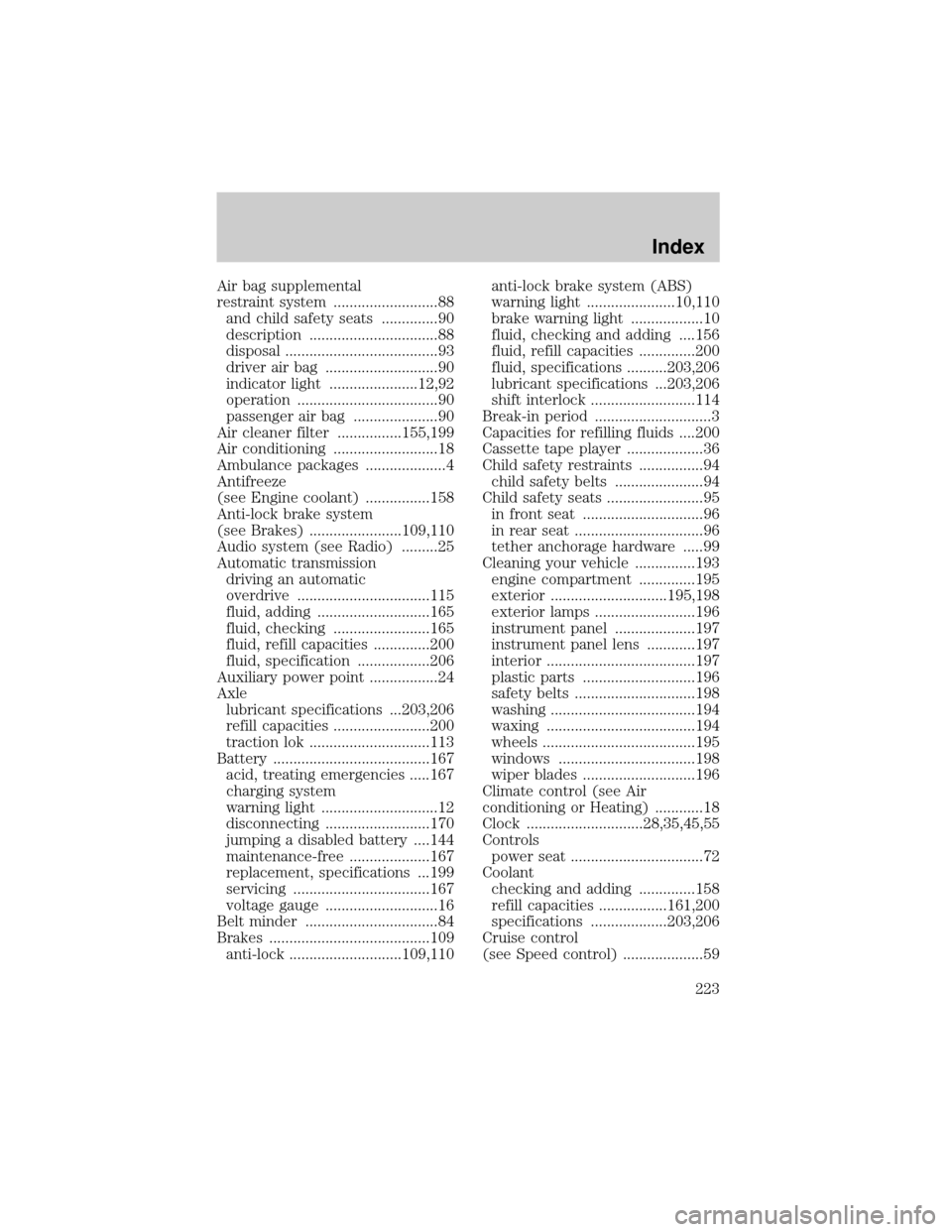
Air bag supplemental
restraint system ..........................88
and child safety seats ..............90
description ................................88
disposal ......................................93
driver air bag ............................90
indicator light ......................12,92
operation ...................................90
passenger air bag .....................90
Air cleaner filter ................155,199
Air conditioning ..........................18
Ambulance packages ....................4
Antifreeze
(see Engine coolant) ................158
Anti-lock brake system
(see Brakes) .......................109,110
Audio system (see Radio) .........25
Automatic transmission
driving an automatic
overdrive .................................115
fluid, adding ............................165
fluid, checking ........................165
fluid, refill capacities ..............200
fluid, specification ..................206
Auxiliary power point .................24
Axle
lubricant specifications ...203,206
refill capacities ........................200
traction lok ..............................113
Battery .......................................167
acid, treating emergencies .....167
charging system
warning light .............................12
disconnecting ..........................170
jumping a disabled battery ....144
maintenance-free ....................167
replacement, specifications ...199
servicing ..................................167
voltage gauge ............................16
Belt minder .................................84
Brakes ........................................109
anti-lock ............................109,110anti-lock brake system (ABS)
warning light ......................10,110
brake warning light ..................10
fluid, checking and adding ....156
fluid, refill capacities ..............200
fluid, specifications ..........203,206
lubricant specifications ...203,206
shift interlock ..........................114
Break-in period .............................3
Capacities for refilling fluids ....200
Cassette tape player ...................36
Child safety restraints ................94
child safety belts ......................94
Child safety seats ........................95
in front seat ..............................96
in rear seat ................................96
tether anchorage hardware .....99
Cleaning your vehicle ...............193
engine compartment ..............195
exterior .............................195,198
exterior lamps .........................196
instrument panel ....................197
instrument panel lens ............197
interior .....................................197
plastic parts ............................196
safety belts ..............................198
washing ....................................194
waxing .....................................194
wheels ......................................195
windows ..................................198
wiper blades ............................196
Climate control (see Air
conditioning or Heating) ............18
Clock .............................28,35,45,55
Controls
power seat .................................72
Coolant
checking and adding ..............158
refill capacities .................161,200
specifications ...................203,206
Cruise control
(see Speed control) ....................59
Index
223
Page 224 of 232
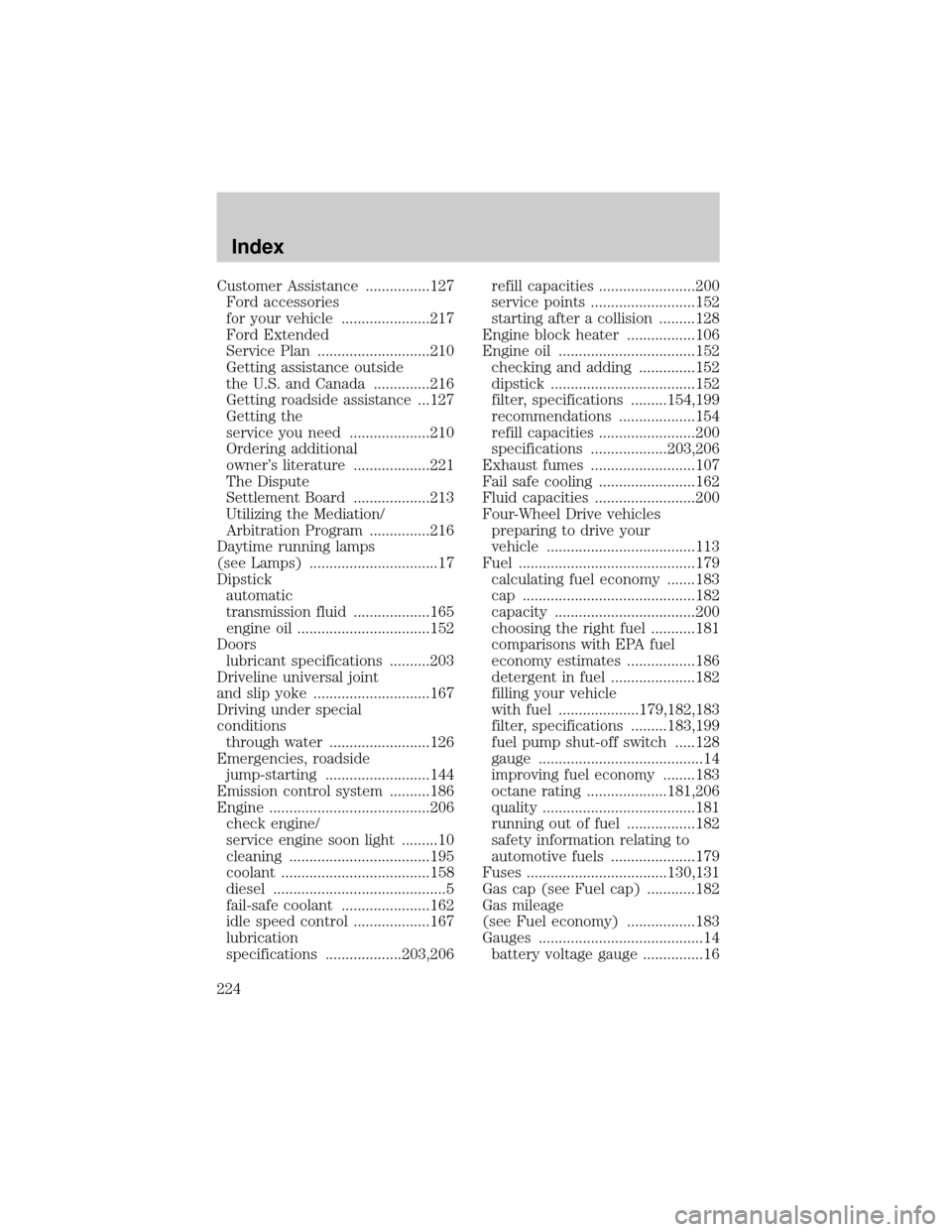
Customer Assistance ................127
Ford accessories
for your vehicle ......................217
Ford Extended
Service Plan ............................210
Getting assistance outside
the U.S. and Canada ..............216
Getting roadside assistance ...127
Getting the
service you need ....................210
Ordering additional
owner's literature ...................221
The Dispute
Settlement Board ...................213
Utilizing the Mediation/
Arbitration Program ...............216
Daytime running lamps
(see Lamps) ................................17
Dipstick
automatic
transmission fluid ...................165
engine oil .................................152
Doors
lubricant specifications ..........203
Driveline universal joint
and slip yoke .............................167
Driving under special
conditions
through water .........................126
Emergencies, roadside
jump-starting ..........................144
Emission control system ..........186
Engine ........................................206
check engine/
service engine soon light .........10
cleaning ...................................195
coolant .....................................158
diesel ...........................................5
fail-safe coolant ......................162
idle speed control ...................167
lubrication
specifications ...................203,206refill capacities ........................200
service points ..........................152
starting after a collision .........128
Engine block heater .................106
Engine oil ..................................152
checking and adding ..............152
dipstick ....................................152
filter, specifications .........154,199
recommendations ...................154
refill capacities ........................200
specifications ...................203,206
Exhaust fumes ..........................107
Fail safe cooling ........................162
Fluid capacities .........................200
Four-Wheel Drive vehicles
preparing to drive your
vehicle .....................................113
Fuel ............................................179
calculating fuel economy .......183
cap ...........................................182
capacity ...................................200
choosing the right fuel ...........181
comparisons with EPA fuel
economy estimates .................186
detergent in fuel .....................182
filling your vehicle
with fuel ....................179,182,183
filter, specifications .........183,199
fuel pump shut-off switch .....128
gauge .........................................14
improving fuel economy ........183
octane rating ....................181,206
quality ......................................181
running out of fuel .................182
safety information relating to
automotive fuels .....................179
Fuses ...................................130,131
Gas cap (see Fuel cap) ............182
Gas mileage
(see Fuel economy) .................183
Gauges .........................................14
battery voltage gauge ...............16
Index
224
Page 225 of 232
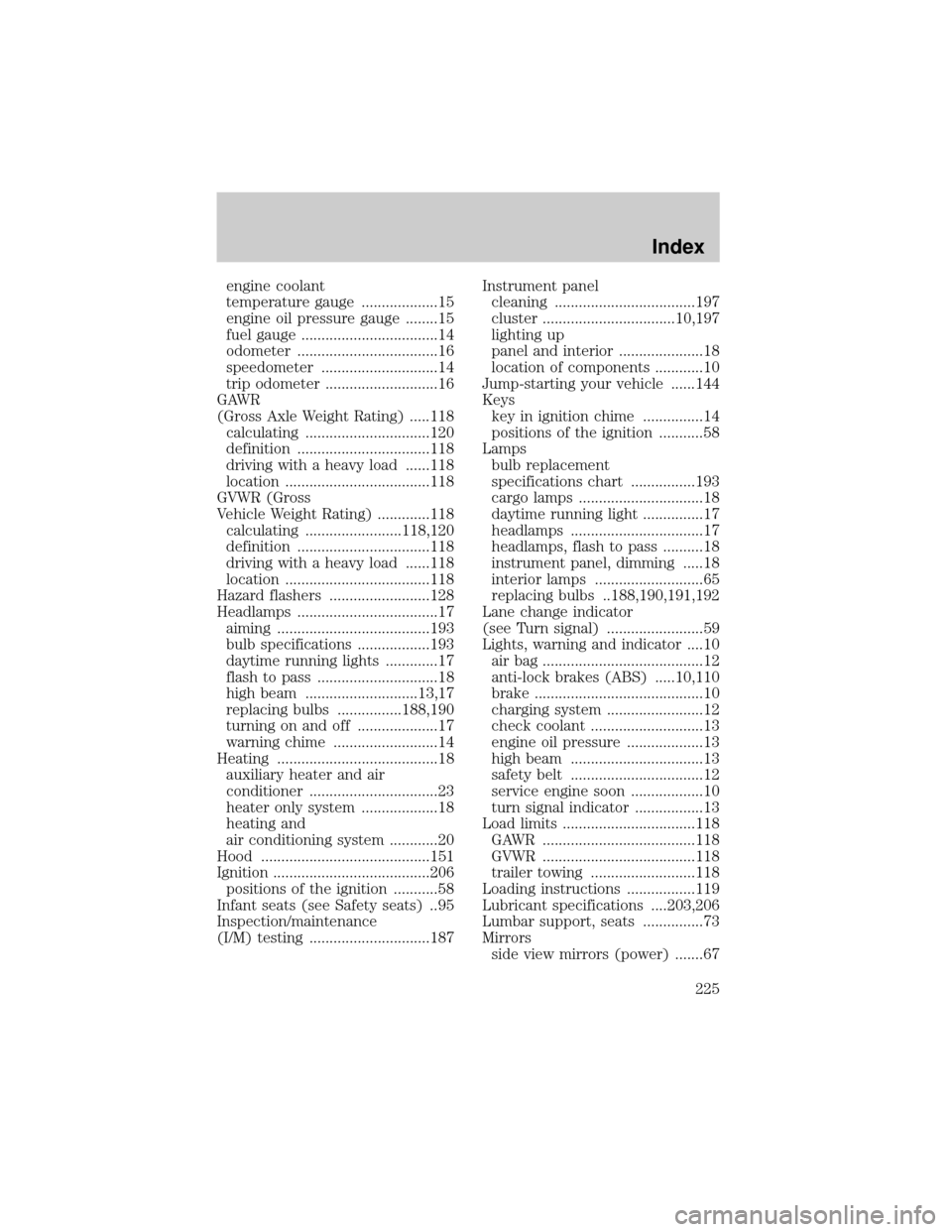
engine coolant
temperature gauge ...................15
engine oil pressure gauge ........15
fuel gauge ..................................14
odometer ...................................16
speedometer .............................14
trip odometer ............................16
GAWR
(Gross Axle Weight Rating) .....118
calculating ...............................120
definition .................................118
driving with a heavy load ......118
location ....................................118
GVWR (Gross
Vehicle Weight Rating) .............118
calculating ........................118,120
definition .................................118
driving with a heavy load ......118
location ....................................118
Hazard flashers .........................128
Headlamps ...................................17
aiming ......................................193
bulb specifications ..................193
daytime running lights .............17
flash to pass ..............................18
high beam ............................13,17
replacing bulbs ................188,190
turning on and off ....................17
warning chime ..........................14
Heating ........................................18
auxiliary heater and air
conditioner ................................23
heater only system ...................18
heating and
air conditioning system ............20
Hood ..........................................151
Ignition .......................................206
positions of the ignition ...........58
Infant seats (see Safety seats) ..95
Inspection/maintenance
(I/M) testing ..............................187Instrument panel
cleaning ...................................197
cluster .................................10,197
lighting up
panel and interior .....................18
location of components ............10
Jump-starting your vehicle ......144
Keys
key in ignition chime ...............14
positions of the ignition ...........58
Lamps
bulb replacement
specifications chart ................193
cargo lamps ...............................18
daytime running light ...............17
headlamps .................................17
headlamps, flash to pass ..........18
instrument panel, dimming .....18
interior lamps ...........................65
replacing bulbs ..188,190,191,192
Lane change indicator
(see Turn signal) ........................59
Lights, warning and indicator ....10
air bag ........................................12
anti-lock brakes (ABS) .....10,110
brake ..........................................10
charging system ........................12
check coolant ............................13
engine oil pressure ...................13
high beam .................................13
safety belt .................................12
service engine soon ..................10
turn signal indicator .................13
Load limits .................................118
GAWR ......................................118
GVWR ......................................118
trailer towing ..........................118
Loading instructions .................119
Lubricant specifications ....203,206
Lumbar support, seats ...............73
Mirrors
side view mirrors (power) .......67
Index
225